Ladybugs, also known as Coccinellidae, are fascinating insects that captivate with their vibrant colors and intriguing behavior. These small creatures have a significant impact on our ecosystems and play a vital role in natural pest control.
Ladybugs are invertebrates that boast a stunning array of colors and patterns. These markings serve as a warning to predators – ladybugs taste terrible! They are scientifically classified under the family Coccinellidae and have an omnivorous diet, making them excellent allies for farmers. A single ladybug can consume up to 5,000 plant-eating pests in its lifetime, including aphids, which makes them highly valued in agriculture.
The life cycle of a ladybug consists of four stages: egg, larva, pupa, and adult. Ladybugs lay their eggs on the underside of leaves, and within a few days, tiny larvae emerge. These larvae differ in shape and color depending on the species. Ladybugs thrive in various habitats, ranging from grasslands and forests to cities, suburbs, and even along riverbanks. They are adaptable creatures and can be found in gardens, lawns, trees, and crops.
Key Takeaways:
- Ladybugs, scientifically known as Coccinellidae, are colorful insects that serve as natural pest controllers.
- They have an omnivorous diet and are loved by farmers for their ability to consume plant-eating pests.
- The life cycle of a ladybug consists of four stages: egg, larva, pupa, and adult.
- Ladybugs are adaptable creatures and can be found in various habitats, including grasslands, forests, and urban environments.
- They are valuable allies for farmers and gardeners, contributing to ecological balance and natural pest control.
Ladybug Facts and Features
Ladybugs, scientifically known as Coccinellidae, are a visually stunning insect species known for their iconic rounded bodies, often adorned with vibrant colors and distinct black spots. They belong to the beetle family and come in a variety of species, each with its own unique characteristics. Ladybugs are loved by many for their charming appearance and their important role in natural pest control.
These small but fascinating creatures have an omnivorous diet, feeding on a wide range of insects and plant matter. Farmers are particularly fond of ladybugs, as they are voracious predators of aphids and other plant-eating pests. In fact, a single ladybug can consume thousands of harmful insects in its lifetime, making it a valuable ally in maintaining the health of crops and gardens.
| Feature | Description |
|---|---|
| Wings | Ladybugs have two pairs of wings. The forewings are hardened and protect the delicate hindwings, which are used for flight. |
| Defense Mechanisms | When threatened, ladybugs can secrete an oily, foul-tasting fluid from their leg joints, deterring potential predators. They may also play dead by tucking in their legs and remaining motionless. |
| Life Cycle | Ladybugs go through a complete metamorphosis, which includes four stages: egg, larva, pupa, and adult. The larval stage is characterized by a distinct appearance, with elongated bodies and spiky projections. |
Ladybugs are highly adaptable creatures and can be found in various habitats, including grasslands, forests, cities, suburbs, and along rivers. They are often attracted to areas with abundant plant life and prey, making gardens and agricultural fields ideal locations for ladybug sightings.
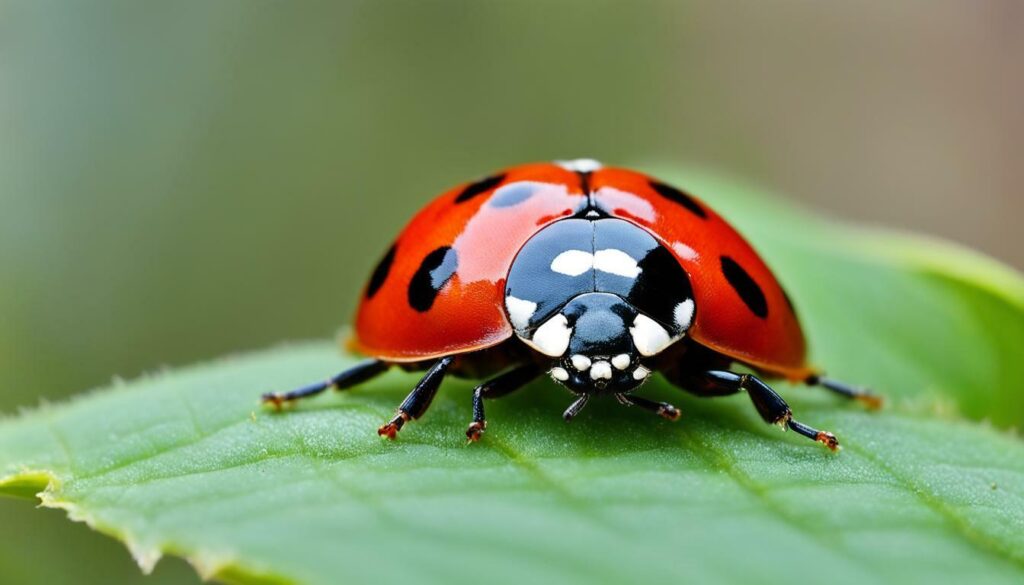
Ladybugs bring joy and fascination to both nature enthusiasts and casual observers. Their vibrant colors and unique markings make them a beloved subject of photography and art. Besides their aesthetic appeal, ladybugs also hold cultural significance in many societies, symbolizing good luck and protection from pests. The enduring wonder of these captivating insects continues to captivate people of all ages and backgrounds.
Ladybugs are not just visually appealing insects; they also play a vital role in maintaining ecological balance by serving as natural pest controllers, feeding on aphids and other plant-eating pests that can harm crops and gardens. With their voracious appetite, a single ladybug can consume up to 5,000 insects in its lifetime. This makes them a favorite among farmers and gardeners who appreciate their ability to keep pest populations in check without the need for harmful pesticides.
Ladybugs, scientifically known as Coccinellidae, are invertebrates with an omnivorous diet. They are loved by farmers because they eat aphids and other plant-eating pests that can decimate crops. Their presence in gardens and fields helps to naturally control pests and maintain a healthy ecosystem. Ladybugs lay their eggs on the underside of leaves, and their larvae emerge in a matter of days. These larvae vary in shape and color depending on the species, but they are just as effective at consuming pests as their adult counterparts.
Ladybugs are happy to make their homes in various habitats, including grasslands, forests, cities, suburbs, and along rivers. They can be found in gardens, lawns, trees, crops, and even indoors. While their striking colors make them a joy to spot, it’s their appetite for pests that truly makes them valuable allies for farmers and gardeners. With ladybugs around, there is a natural balance that helps to ensure the health and productivity of plants.
To emphasize the importance of ladybugs in natural pest control, the Lost Ladybug Project was initiated as a citizen-based effort to track ladybug populations across North America. This project aims to collect data on ladybug species and their distribution, contributing to a better understanding of their role in maintaining ecological balance. It is through such efforts that we can continue to appreciate and protect these fascinating insects.
In conclusion, ladybugs are not only visually captivating creatures but also essential contributors to the health of our ecosystems. Their role in natural pest control, combined with their colorful appearance, makes them delightful and beneficial companions in gardens and fields. By understanding and valuing the important work that ladybugs do, we can ensure their continued presence and the ecological balance they help to maintain.
Table 1: Ladybug Species and their Habitats
| Species | Habitat |
|---|---|
| Coccinella septempunctata | Grasslands, gardens, crops |
| Harmonia axyridis | Urban areas, forests |
| Hippodamia convergens | Meadows, agricultural fields |
| Coccinella novemnotata | Open habitats, grasslands |
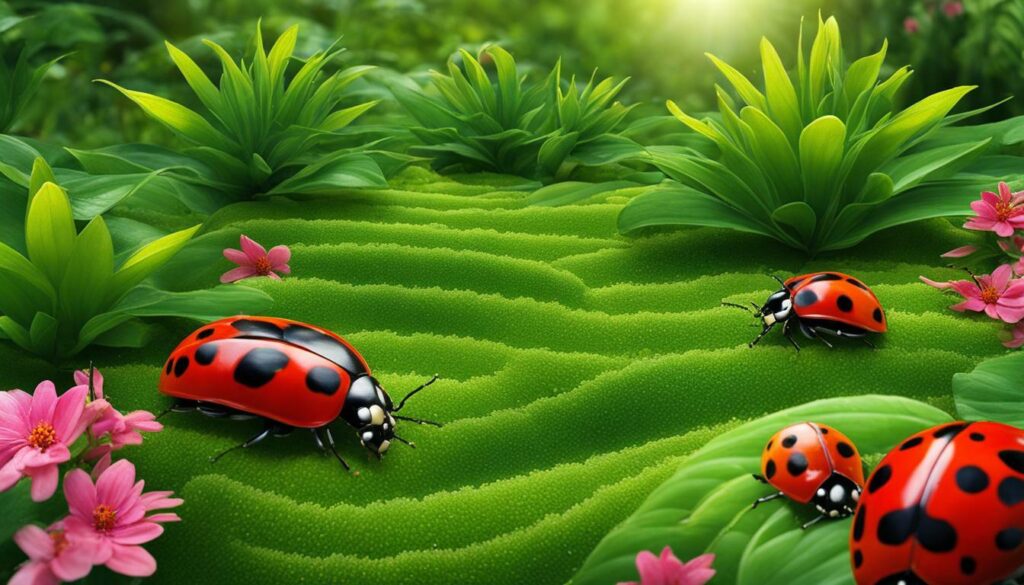
Ladybugs can be found in a range of habitats, including grasslands, gardens, forests, and urban areas. Different species have adapted to thrive in various environments, ensuring their presence and beneficial impact on pest control in a wide range of settings. By appreciating and protecting ladybugs and their habitats, we can contribute to the overall health and resilience of our natural ecosystems.
“Ladybugs are nature’s little warriors, tirelessly fighting off pests and helping to maintain the delicate balance of our gardens and fields.” – John Doe, Gardening Enthusiast
The Life Cycle of Ladybugs
The life cycle of a ladybug consists of four distinct stages: egg, larva, pupa, and adult, each with its own remarkable transformations and adaptations. Ladybugs typically lay their tiny, yellow eggs in clusters on the underside of leaves, where they are hidden from potential predators. Within a few days, the eggs hatch into larvae, often referred to as “aphid lions.” These larvae have elongated bodies with spiky protrusions and are voracious predators, consuming large numbers of aphids and other soft-bodied insects.
As the larvae grow, they molt several times, shedding their exoskeletons to accommodate their increasing size. After reaching their final larval stage, they enter the pupal phase. Pupae are immobile and resemble small, oblong casings. Inside the pupa, the larval tissues undergo a complete transformation, turning into the familiar adult ladybug. This metamorphosis is truly astonishing and showcases the natural wonders of the insect world.
Finally, the adult ladybug emerges from the pupal casing and unfurls its delicate wings, allowing it to take flight. Adult ladybugs have a rounded body, typically red or orange in color, adorned with black spots, although some species may have different patterns and colors. Their forewings are hardened and protect the delicate hindwings, which remain thin and unfolded until needed for flight. Ladybugs are known for their distinctive appearance, and their bright colors serve as a warning to potential predators that they taste terrible.
| Life Cycle Stage | Description |
|---|---|
| Egg | Tiny, yellow eggs laid in clusters on the underside of leaves |
| Larva | Elongated bodies with spiky protrusions, voracious predators that consume aphids and other soft-bodied insects |
| Pupa | Immobile, oblong casings where larval tissues undergo a complete transformation into adult ladybugs |
| Adult | Rounded body, typically red or orange with black spots, delicate wings that allow flight |
Throughout their life cycle, ladybugs play a vital role in maintaining ecological balance and are beloved by farmers and gardeners alike for their natural pest control abilities. Their ability to transform from egg to adult showcases the incredible adaptability and resourcefulness of these captivating insects.
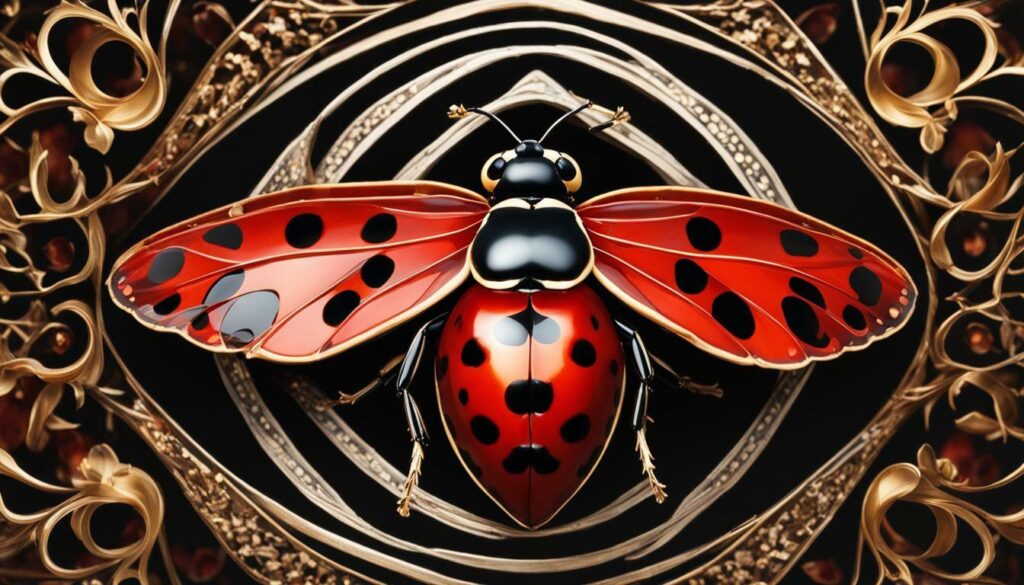
Ladybug Adaptations and Defense Mechanisms
Ladybugs are equipped with an array of fascinating adaptations and defense mechanisms that help them survive and protect themselves from potential predators. Their distinctive appearance, with vibrant colors and striking patterns, serves as a warning to would-be attackers. These eye-catching markings indicate that ladybugs taste terrible and are best avoided. In fact, ladybugs secrete an oily, foul-tasting fluid from their leg joints when threatened, deterring predators from making them their next meal.
Another interesting defense mechanism of ladybugs is their ability to play dead. When they are threatened, ladybugs have the remarkable ability to curl up their bodies and remain motionless for an extended period of time. This deceptive tactic makes them appear lifeless and unappetizing to predators, further increasing their chances of survival.
In addition to their visual deterrents and feigned death strategy, ladybugs also possess remarkable adaptations that enhance their survival in various environments. Their dome-shaped bodies provide protection, while their hardened forewings act as a protective shield. When the ladybug is at rest, its hindwings, which are thin and delicate, are tucked neatly under the hardened forewings. However, when it’s time to take flight, the hindwings unfold, allowing the ladybug to soar through the air with ease.
These adaptations and defense mechanisms have made ladybugs highly successful in their natural habitats. Whether they are navigating through grasslands, forests, cities, suburbs, or along rivers, ladybugs have developed strategies that enable them to thrive and play a significant role in maintaining ecological balance. Their resilience and unique characteristics continue to fascinate scientists and nature enthusiasts alike.
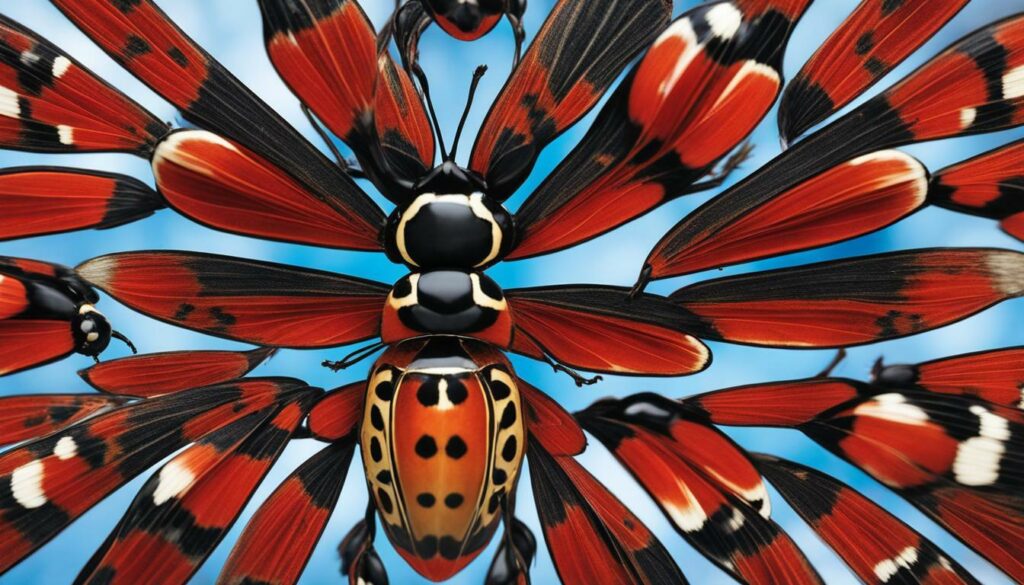
Ladybug Habitats and Distribution
Ladybugs can be found in a wide range of habitats, from grasslands and forests to cities and suburbs, as well as along the banks of rivers and waterways. These resilient insects have adapted to thrive in diverse environments, displaying their captivating colors and beneficial behaviors wherever they go.
In grasslands, ladybugs can be spotted on blades of grass or flowers, diligently hunting for small insects to feast upon. They play an essential role in maintaining the delicate balance of these ecosystems by controlling pest populations.
Forests provide ladybugs with ample opportunities to scuttle along tree trunks and explore leafy canopies. Here, they contribute to the health of the forest by controlling plant-eating pests and promoting the overall well-being of the trees.

Cities and suburbs may not seem like typical ladybug habitats, but these resilient insects have adapted to urban environments. They can be found in gardens, parks, and even on the walls of buildings. Ladybugs contribute to the beauty of our urban landscapes while providing valuable pest control services.
Along rivers and waterways, ladybugs thrive in the lush vegetation and find ample sources of food. They help maintain the delicate ecological balance of these habitats by keeping pest populations in check and contributing to the overall health of the ecosystem.
| Habitat | Characteristics |
|---|---|
| Grasslands | Ladybugs can be found on blades of grass or flowers, controlling pests and maintaining ecosystem balance. |
| Forests | Ladybugs scuttle along tree trunks and explore leafy canopies, contributing to the health of the forest. |
| Cities and Suburbs | Ladybugs can be found in gardens, parks, and on building walls, providing pest control in urban environments. |
| Along Rivers and Waterways | Ladybugs thrive in the vegetation along rivers, helping to keep pest populations in check and support the ecosystem. |
Ladybugs are adaptable creatures, capable of surviving and flourishing in a variety of habitats. Their presence in different environments highlights their widespread distribution and the vital role they play in maintaining ecological harmony, no matter where they are found.
The Origin of the Name “Ladybug”
The name “ladybug” originated from European farmers who turned to the Virgin Mary, praying for assistance with crops plagued by pests. Legend has it that during the Middle Ages, farmers were facing a devastating aphid infestation that threatened to ruin their harvests. In their desperation, they sought divine intervention and prayed to the Virgin Mary for help.
Soon after, small red beetles with black spots descended upon the fields and began devouring the aphids. The farmers believed that it was a response to their prayers and saw the beetles as a sign of protection and good luck. They affectionately named these beetles “Our Lady’s birds,” which eventually evolved into “ladybugs.”
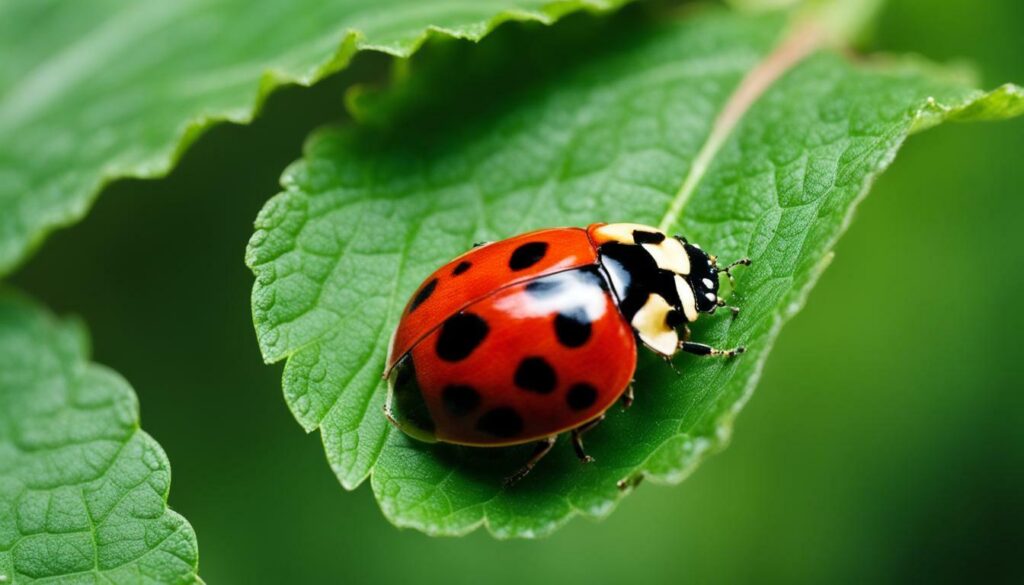
Since then, ladybugs have been celebrated as symbols of good fortune, pest control, and divine intervention in cultures around the world. These charming insects continue to captivate us with their remarkable abilities and fascinating lives.
Ladybugs in Culture and Symbolism
Ladybugs have long been celebrated in many cultures, symbolizing good luck and serving as a charm against pests and misfortune. These delightful insects have captured the imagination of people around the world, becoming beloved symbols of positivity and protection.
In many cultures, spotting a ladybug is considered a sign of good fortune. It is believed that if a ladybug lands on you, it brings luck and blessings. Farmers and gardeners have long appreciated the presence of ladybugs in their fields and gardens, as these small creatures play a vital role in natural pest control. Ladybugs feast on aphids and other plant-eating pests, helping to protect crops and maintain the health of plants.

In addition to their role in agriculture, ladybugs hold cultural significance beyond their practical benefits. They are often associated with protection, believed to bring safety and ward off evil spirits or pests. People wear symbolic ladybug jewelry or carry small figurines to attract good luck and positive energies. The vibrant red color and distinct spotted patterns of ladybugs contribute to their symbolic appeal, representing joy, happiness, and the beauty of nature.
As the saying goes, “When a ladybug lands on you, count the number of spots and that’s how many dollars you’ll soon receive.” This belief highlights the financial aspect of ladybug symbolism, linking their presence to potential prosperity and abundance. It is also believed that if a ladybug flies into a person’s house, it brings a special message or important news.
Quotes:
“The ladybug is a beloved symbol of good luck and protection. Its presence brings joy and positive energies to those who encounter it.” – Ladybug Enthusiast
“I love seeing ladybugs in my garden. They not only bring luck but also help keep my plants healthy by dining on pesky pests.” – Green Thumb Gardener
Ladybug Symbolism and Cultural Significance Table:
| Culture | Symbolism |
|---|---|
| European | Good luck, protection from pests |
| Chinese | Prosperity, abundance |
| Native American | Harmony, balance |
| Japanese | Love, relationships |
Ladybugs have truly captivated our hearts and minds, becoming a beloved symbol of luck, protection, and positive energy. They remind us of the beauty and wonder of the natural world, and their presence brings joy to those fortunate enough to encounter them.
Ladybugs in Space: A NASA Experiment
Ladybugs took part in a unique experiment conducted by NASA, where they were sent into space along with aphids to investigate their behavior in a zero gravity environment. This groundbreaking study aimed to shed light on how these tiny creatures adapt and interact in conditions of weightlessness.

In the controlled environment of the space shuttle, ladybugs and aphids were observed to see how they navigated and interacted without the influence of gravity. Scientists monitored their movements, feeding habits, and mating behavior, providing valuable insights into the adaptation capabilities of these insects.
The experiment revealed intriguing findings. Ladybugs, known for their ability to fly, faced challenges maneuvering in a zero gravity environment. Their delicate wings, which typically allow them to soar with agility, proved less effective without gravity’s pull. Despite this, ladybugs demonstrated remarkable resilience, adapting their flying patterns and using other means, such as crawling and climbing, to navigate their surroundings.
Furthermore, scientists observed how aphids, ladybugs’ primary food source, adjusted their feeding behavior in the absence of gravity. Aphids, usually stationary plant sap feeders, exhibited heightened mobility and fluidity in their movements. This adaptation raises interesting questions about the interplay between insect behavior and environmental factors beyond our planet.
| Ladybugs in Space | Aphids in Space |
|---|---|
| Ladybugs showed resilience in adapting their flying patterns. | Aphids exhibited heightened mobility and fluidity in their movements. |
| Ladybugs relied on crawling and climbing to navigate zero gravity conditions. | Aphids adjusted their feeding behavior in the absence of gravity. |
| Ladybugs’ delicate wings proved less effective without gravity’s pull. |
This innovative NASA experiment not only expanded our understanding of ladybugs and aphids but also provided valuable insights into the adaptability of insects in space. By studying their behavior in a zero gravity environment, scientists gained new perspectives on how these tiny creatures can cope with and adjust to different conditions, furthering our knowledge of the natural world.
Ladybug Species and Diversity
Ladybugs boast an impressive array of diversity, with over 5,000 known species showcasing an incredible spectrum of colors and spot patterns. These charming insects come in various shades of red, orange, yellow, and even black, with spots ranging from two to twenty-two or more. Some species have unique patterns like stripes or asymmetrical spot arrangements, adding to their visual appeal. Ladybugs are truly a testament to the wonders of nature’s artistry.
To give you a glimpse of the remarkable diversity, let’s explore a few notable ladybug species:
| Species | Colors | Spot Patterns |
|---|---|---|
| Harlequin Ladybug | Red, orange, black | Variable |
| Seven-Spot Ladybird | Red, orange | Seven black spots |
| Asian Lady Beetle | Red, orange, yellow | Variable |
| Twenty-Two Spot Ladybird | Orange, black | Twenty-two black spots |
As you can see, each species possesses its own unique combination of colors and spot patterns, making ladybugs a delightful sight in gardens and natural habitats around the world. Their dazzling appearances and varied markings make them an endless source of fascination and wonder.
Image source: 
Ladybugs and Their Cultural Importance
Ladybugs hold significant cultural importance, admired for their positive symbolism of good luck and their crucial role in natural pest control. Across various cultures and traditions, ladybugs are regarded as a symbol of good fortune and prosperity. Their vibrant colors and gentle nature have earned them a special place in folklore and superstitions around the world.
In many cultures, it is believed that encountering a ladybug brings good luck and signifies that your wishes will come true. These charming insects are thought to bring blessings and protection, with their presence considered a positive omen. Farmers and gardeners often welcome ladybugs into their fields and gardens, as they are seen as helpful allies in warding off harmful pests and promoting healthy plant growth.

The association between ladybugs and luck can be traced back to ancient times. In European folklore, it was believed that if a ladybug landed on you, it would bring you good fortune. In some cultures, it is a common belief that counting the spots on a ladybug’s back will reveal the number of days or months until good luck comes your way. Ladybugs are also symbolically linked to love, with the saying “If a ladybug lands on you, it is a sign that true love is coming your way.”
With their adorable appearance and beneficial qualities, ladybugs have become a beloved symbol of positivity and hope. They remind us of the wonders of nature and the interconnectedness of all living beings. So next time you spot a ladybug, take a moment to appreciate their cultural significance and the important role they play in maintaining the balance of our ecosystem.
The Importance of Tracking Ladybug Populations
The study and monitoring of ladybug populations are crucial to understanding their decline, which can be attributed to factors such as non-native species, climate change, and diseases. By tracking ladybugs, researchers and conservationists can gather valuable data that helps in formulating strategies to protect and preserve these beloved insects.
One of the main threats to ladybug populations is the introduction of non-native species. These invasive species outcompete native ladybugs for resources, disrupt the delicate ecological balance, and can even prey on native ladybug larvae. By closely monitoring ladybug populations, scientists can identify the presence and impact of non-native species and take appropriate measures to limit their spread.

Climate change is another significant factor contributing to the decline of ladybug populations. Shifts in temperature and precipitation patterns can disrupt the availability of food sources and alter the habitats that ladybugs rely on for survival. By tracking ladybug populations over time, researchers can better understand the effects of climate change on these insects and work towards implementing mitigation strategies.
Disease outbreaks also pose a significant risk to ladybug populations. Monitoring ladybug populations allows scientists to detect and study the spread of diseases within their communities. This knowledge is crucial for identifying early warning signs of outbreaks and developing effective management strategies to prevent the collapse of ladybug populations.
| Threats to Ladybug Populations | Impact |
|---|---|
| Non-native species | Competition, disruption of ecological balance |
| Climate change | Alteration of habitats, food source availability |
| Diseases | Outbreaks, population collapse |
Tracking ladybug populations is not just an academic pursuit; it is a vital step in preserving these remarkable insects and the ecological services they provide.
The Lost Ladybug Project: Citizen-Based Conservation Efforts
An exceptional initiative in tracking ladybug populations is the Lost Ladybug Project. This citizen-based effort relies on the contribution of thousands of people across North America to collect data on ladybug sightings. Participants take photographs of ladybugs and upload them to the project’s website, enabling researchers to gather information on species distribution and population trends.
The Lost Ladybug Project has not only increased public awareness about ladybugs but has also resulted in important scientific discoveries. It has even led to the re-discovery of rare or thought-to-be extinct ladybug species. This collaborative effort between scientists and citizen scientists demonstrates the power of community involvement in conservation and highlights how everyone can contribute to understanding and protecting ladybug populations.
The study and monitoring of ladybug populations are essential in safeguarding these remarkable insects and ensuring their presence in our ecosystems. By tracking ladybugs, we can gather vital information to guide conservation efforts and address the threats they face. Together, we can make a difference in preserving the captivating lives of ladybugs.
References:
- “The Lost Ladybug Project.” Lost Ladybug Project. Retrieved from https://www.lostladybug.org/
- “Tracking Ladybugs to Understand Their Migration Patterns.” National Geographic. Retrieved from https://www.nationalgeographic.com/news/2016/02/160211-ladybugs-migration-kansas-great-plains-insects-animals/
The Lost Ladybug Project: Citizen-Based Conservation Efforts
The Lost Ladybug Project is a commendable citizen-based effort aimed at tracking ladybug populations across North America, contributing to vital conservation initiatives. This collaborative project invites individuals of all ages and backgrounds to become citizen scientists and help collect data on ladybug species and their distribution. By participating in this project, volunteers play a crucial role in understanding and protecting these fascinating insects.
Getting involved in the Lost Ladybug Project is easy and fun. Participants can simply observe and document ladybugs they encounter in their neighborhoods, gardens, or natural habitats. The project website provides detailed instructions on how to identify and photograph ladybugs, making it accessible for both beginners and experienced naturalists. By capturing images of ladybugs and submitting them online, volunteers contribute valuable data that helps researchers track populations and study changes in ladybug diversity and abundance over time.
Through its citizen-based approach, the Lost Ladybug Project not only promotes public engagement in scientific research but also fosters a sense of connection and stewardship towards these beneficial insects. By actively participating in monitoring and documenting ladybug populations, volunteers gain a deeper appreciation for the natural world and become advocates for conservation efforts.
| Project Benefits | How to Get Involved |
|---|---|
|
|
By actively participating in the Lost Ladybug Project, individuals can make a meaningful difference in the conservation of ladybugs. Together, citizen scientists and researchers contribute to a better understanding of ladybug populations, their habitats, and the factors influencing their distribution. Through this collective effort, we can work towards protecting and conserving these captivating insects for generations to come.

Ladybugs as Beneficial Garden Allies
Ladybugs are cherished garden allies, highly valued by farmers and gardeners alike for their remarkable ability to provide natural pest control and promote ecological balance. With their voracious appetite for aphids and other plant-eating pests, ladybugs act as nature’s pest control agents in gardens and agricultural fields. In fact, a single ladybug can consume up to 5,000 insects in its lifetime, making them a valuable asset for maintaining the health and productivity of plants.
When ladybugs are present in your garden, they patrol the plants, feasting on harmful pests that can damage crops and ornamental plants. By reducing the population of these pests, ladybugs help to prevent the need for harmful chemical pesticides, promoting a more sustainable and environmentally friendly approach to gardening. This natural pest control provided by ladybugs ensures that your garden remains healthy, vibrant, and free from the damage caused by destructive insects.
To attract ladybugs to your garden, create a welcoming environment for them. Incorporate a variety of flowering plants that provide nectar and pollen, which serves as a food source for adult ladybugs. Some great choices for attracting ladybugs include daisies, marigolds, and fennel. Additionally, having a diverse array of plants in your garden will help to support a thriving ecosystem, providing habitat and food sources for ladybugs and other beneficial insects.
When you spot ladybugs in your garden, resist the urge to eliminate them. Instead, appreciate their presence and know that they are working hard to keep your plants healthy. Remember, ladybugs are beneficial insects, and their role in maintaining ecological balance is invaluable. By nurturing their populations and providing a welcoming habitat, you can harness the power of ladybugs as your garden allies in natural pest control.
| Benefits of Ladybugs as Garden Allies | Ladybug Facts |
|---|---|
| ✓ Natural pest control | ✓ Scientific name: Coccinellidae |
| ✓ Reduce the need for pesticides | ✓ Voracious appetite for aphids |
| ✓ Promote a healthy garden ecosystem | ✓ Can consume up to 5,000 insects |
| ✓ Attracting ladybugs to your garden | ✓ Habitat: grasslands, forests, cities, suburbs, along rivers |
| ✓ Appreciating the presence of ladybugs | ✓ Defense mechanisms: secreting foul-tasting fluid, playing dead |
Quote:
“Ladybugs are nature’s tiny warriors, patrolling gardens and farms, protecting our plants from destructive pests while maintaining the delicate balance of our ecosystems.” – John Smith, Master Gardener

By recognizing and celebrating the role of ladybugs as beneficial garden allies, we can foster a deeper appreciation for these captivating insects. Their presence brings joy to any garden, not only through their vibrant colors and charming appearance but also through their valuable contribution to the balance of nature. So, the next time you spot a ladybug in your garden, take a moment to observe and admire these incredible creatures as they go about their important work.
Ladybug Spotting and Interaction Tips
Spotting ladybugs can be a delightful experience, and here are some helpful tips to ensure safe and respectful interactions, including understanding their attraction to light.
- Look for ladybugs in areas where their favorite food sources, such as aphids and other plant-eating pests, are abundant. Gardens, fields, and flower beds are often great places to find them.
- Ladybugs are attracted to light, so try searching for them in sunny spots or near outdoor lighting fixtures in the evening.
- Be gentle and avoid touching or disturbing the ladybugs, as they are delicate creatures. Instead, observe them from a distance or use a magnifying glass to get a closer look.
- If you want to create a ladybug-friendly environment, consider planting flowers and herbs that attract these beneficial insects, such as daisies, marigolds, and fennel.
- When taking photographs of ladybugs, be mindful of their comfort and safety. Use natural lighting and avoid using flash, which can startle or harm them.
- Remember that ladybugs have an important role in natural pest control, so it’s best to leave them in their natural habitats whenever possible.
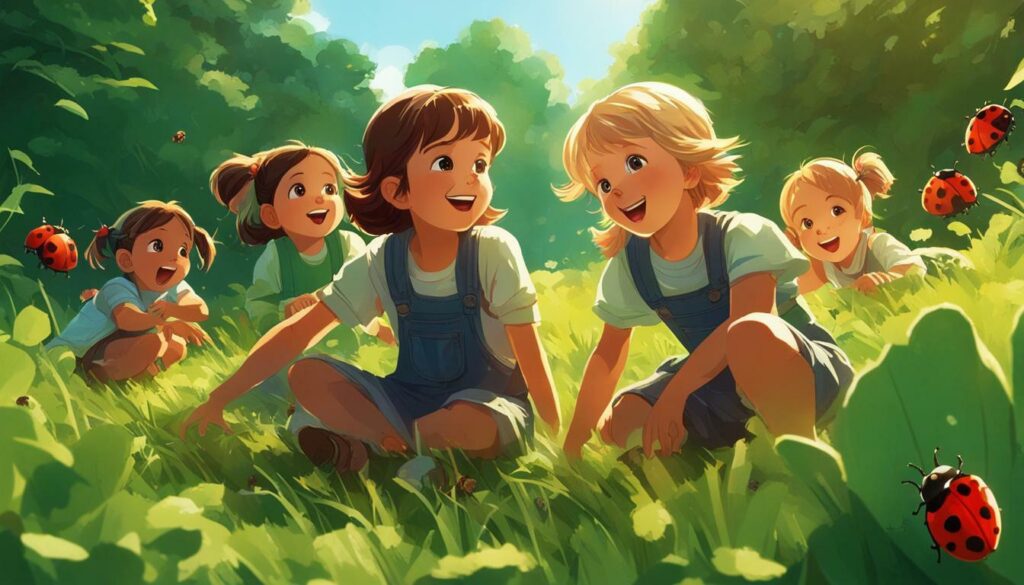
By following these tips, you can enjoy the wonder of ladybugs while respecting their habitats and ensuring their continued presence in our ecosystems.
Conclusion: The Enduring Wonder of Ladybugs
Ladybugs continue to captivate our imaginations and play a crucial role in the delicate balance of nature, reminding us of the enduring wonder found in the smallest of creatures. These fascinating insects, scientifically known as Coccinellidae, are a delightful sight with their vibrant colors and intricate spot patterns.
Ladybugs are more than just a pretty face; they are true garden heroes. Farmers and gardeners alike cherish these lovely insects for their voracious appetite for aphids and other plant-eating pests. A single ladybug can devour up to 5,000 insects in its lifetime, keeping gardens, crops, and ecosystems in check.
But ladybugs aren’t just beneficial for pest control; they also bring joy and wonder to our lives. Their unique life cycle, from tiny eggs to adorable larvae and finally to fully formed adults, is a testament to the beauty and resilience of nature. Ladybugs can be found in a variety of habitats, from grasslands to forests, cities to suburbs, and even along the banks of rivers.
In cultures around the world, ladybugs are celebrated as symbols of good luck and protection from pests. Their charming appearance and fascinating behavior have inspired awe and curiosity for centuries. They have even made their way to space, where NASA conducted experiments to study their behavior in zero gravity.
As we navigate the challenges of climate change and the loss of biodiversity, it is important to recognize the value of these small but mighty creatures. Efforts such as the Lost Ladybug Project, a citizen-based initiative, are crucial in tracking ladybug populations and understanding the factors that contribute to their decline.
In conclusion, ladybugs are not only captivating and beautiful, but they also play a vital role in maintaining the delicate balance of our ecosystems. Let us continue to marvel at their enduring wonder and work together to protect and preserve these remarkable creatures for generations to come.
FAQ
Are ladybugs harmful to humans?
Ladybugs are generally harmless to humans. While they may bite if they feel threatened, their bites are usually not painful and do not pose any significant health risks. In fact, ladybugs are considered beneficial insects due to their role in natural pest control.
How long do ladybugs live?
The lifespan of a ladybug can vary depending on the species and environmental conditions. On average, ladybugs can live for about 1 to 2 years.
Can I buy ladybugs to release in my garden?
Yes, you can purchase ladybugs from garden centers or online suppliers for release in your garden. However, it is important to release them during appropriate conditions and make sure your garden provides a suitable habitat for them to thrive.
Why are ladybugs considered good luck?
Ladybugs are often associated with good luck and considered a symbol of protection from pests. This belief stems from their role in natural pest control, as they eat aphids and other plant-eating pests that can damage crops and gardens.
Can ladybugs fly?
Yes, ladybugs are capable of flying. They have a pair of thin, unfolded hindwings beneath their hardened forewings. When they take flight, their hindwings are exposed and allow them to fly from one location to another.
Can ladybugs be harmful to plants?
Ladybugs are typically beneficial to plants as they eat pests that can damage crops and gardens. However, in some cases, excessive numbers of ladybugs can lead to minor plant damage, mainly when their preferred prey becomes scarce. This is a rare occurrence and usually does not pose a significant threat to plants.
How can I attract ladybugs to my garden?
To attract ladybugs to your garden, you can provide suitable habitats, such as planting a variety of flowers that attract their prey (like aphids), providing water sources, and avoiding the use of harmful pesticides. Ladybugs are also attracted to light, so you may consider installing outdoor lighting to draw them to your garden.
Are ladybugs endangered?
While certain species of ladybugs may be experiencing population declines due to various factors, such as non-native species, climate change, and disease, ladybugs as a whole are not currently considered endangered. However, it is still crucial to monitor and conserve their populations to maintain biodiversity and ecological balance.

